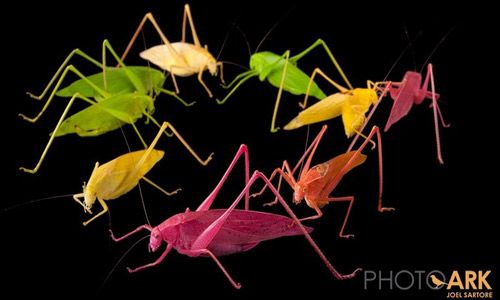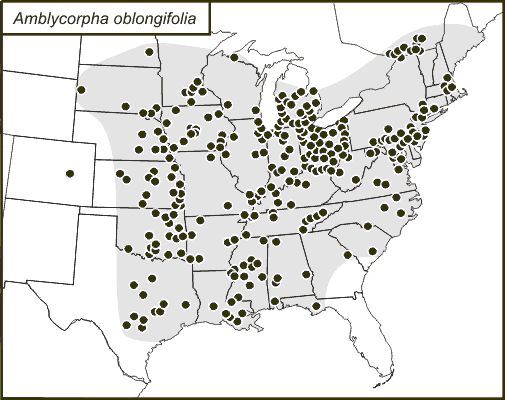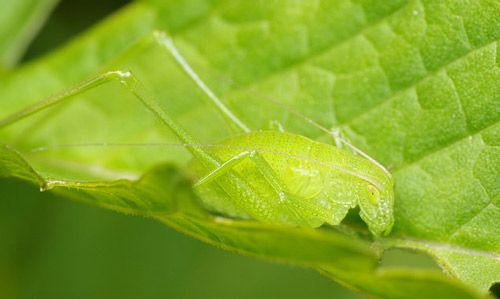The Featured Creatures collection provides in-depth profiles of insects, nematodes, arachnids and other organisms relevant to Florida. These profiles are intended for the use of interested laypersons with some knowledge of biology as well as academic audiences.
Introduction
The oblong-winged katydid, Amblycorypha oblongifolia (De Geer 1773), is a false katydid in the subfamily Phaneropterinae. It is very similar in appearance to Amblycorypha floridana, the Florida false katydid; however, the two species can be differentiated by their calling songs and distribution.
The false katydid adults are distinguishable from the adults of the true katydids (subfamily Pseudophyllinae) by their hind wings which extend beyond their leathery forewings, or tegmina (Kramer 1944). True katydids have relatively shorter forewings, and compared to those of the false katydids, the wings bulge out at the sides (Capinera et al. 2004).
This species of katydid is typically green, but can be pink, orange, tan, brown, or yellow (Figure 1), though it is rare to find these in the wild. Though once thought to be a seasonal color change, entomologist Joseph Hancock, in 1916, discovered the colors are a genetically inherited condition called erythrism (Crew 2013).

Credit: Joel Sartore, Photo Ark
Distribution
The oblong-winged katydid is found throughout the eastern United States, but records of collection are absent from Georgia and most of Florida. Though sometimes confused for Amblycorypha floridana, commonly encountered throughout its range in Florida, Amblycorypha oblongifolia has only been recorded in Florida's panhandle (T.J. Walker, personal communication). It is also found in the Canadian provinces of Québec (mainly Montréal) and Ontario (Kramer 1944).

Credit: Computer-generated distribution map produced in 2003 from records in the GrylTett database
Description
Like all false katydids, Amblycorypha oblongifolia possesses a fully-exposed tympanum at the base of the fore tibia (Capinera et al. 2004). The tympanum senses the call the oblong-winged katydid produces. Katydids create sound by rubbing their wings together. Amblycorypha oblongifolia makes a distinct sound that resembles an "itzic" (Morse 1920). This is distinguishable from the calling song of Amblycorypha floridana, which lasts much longer and sounds like a bouncing table-tennis ball made to buzz when the paddle is lowered down on it so that it starts to bounce very quickly in the small space made (T.J. Walker, personal communication, Capinera et al. 2004). Unlike most species of katydids, males in the Phaneropterinae subfamily approach the females when they detect the females' audible response to their calls (Capinera et al. 2004).
Life Cycle
Eggs
The eggs are deposited in soil and, depending on the location, can take two or more years to hatch (Capinera et al. 2004). In captivity, the Audubon Butterfly Garden and Insectarium has recorded that males from the same cohort hatch before the females (Crew 2013).
Young
The nymphs resemble the adults, except that the abdomen is rounder and they lack wings or sexual characteristics (Figure 3). As the nymphs molt, they develop wing pads. The wings are not fully formed until sexual maturity is reached, which takes about two months (Crew 2013).

Credit: Pascal Gaudette (Doundounba on Flickr, CC BY-NC-SA 2.0)
Adults
The adults range in size from 42 to 52 mm (1.6 to 2 in), with the forewings' length typically 3.1 to 4 times that of the maximum width (Figure 4) (Capinera et al. 2004). Amblycorypha oblongifolia is a round-headed katydid and, like other katydids in the Tettigoniidae family, has four tarsal segments (Capinera et al. 2004).

Credit: Tom Walker, UF/IFAS
Adult abundance peaks once a year between late June and mid-August depending on the latitude (Capinera et al. 2004). The average adult lifespan is four to six months (Crew 2013).
Host Plants
Amblycorypha oblongifolia frequents the understory of deciduous forests, shrubs, and tall weeds, mostly in damp places (Capinera et al. 2004). Additionally, this species of katydid is commonly found on goldenrod (Asteraceae: Solidago) flowers and other related plants along fences and the edges of thickets (Arnett 2000). This katydid is not known to damage economically important plants.
Management
Should prevention of crop damage be needed, registered insecticides for that crop can be used, but alternative methods are available. Covering plants with netting or floating row covers, a light-weight material that covers crops, will keep the katydids out (Capinera et al. 2004). In Florida, protection of plants from katydid damage is necessary only on citrus seedlings for Microcentrum rhombifolium, the greater angle-wing katydid (T. J. Walker personal communication).
The best way to deal with these katydids is to tolerate their presence. In most cases, management is not required since only minor damage occurs.
Selected References
Arnett Jr RH. 2000. Orthoptera (grasshoppers, crickets, and katydids), pp. 153–160. In American insects: A handbook of the insects of America north of Mexico, 2nd ed. Boca Raton, FL: CRC Press.
Capinera JL, Scott RD, Walker TJ. 2004. Katydids, pp. 155-160. In Field guide to grasshoppers, katydids, and crickets of the United States. Ithaca, NY: Cornell University Press.
Crew B. (2013). In North American katydids, green isn't the dominant colour, pink is. Scientific American Blog Network. (3 September 2015).
Kramer S. 1944. "The external morphology of the oblong-winged katydid Amblycorypha oblongifolia (De Geer) (Orthoptera Tettigoniidae)." Annals of the Entomological Society of America 37: 167–192.
Morse AP. 1920. "Manual of the Orthoptera of New England, including the locusts, grasshoppers, crickets, and their allies." Proceedings of the Boston Society of Natural History 35: 197–556.
Walker TJ. (2000). Florida false katydid, Amblycorypha floridana Rehn and Hebard 1905. Singing Insects of North America. (30 September 2015).